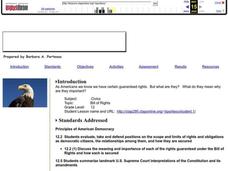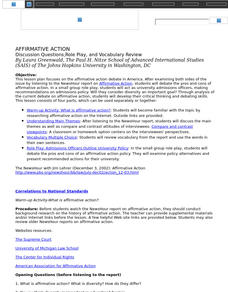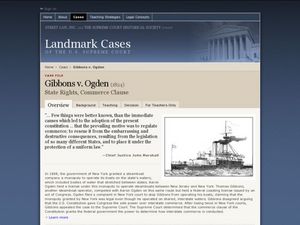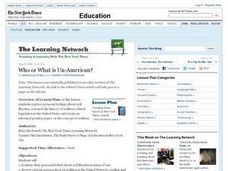Curated OER
Mueller v. Allen
Students investigate a First Amendment legal case involving religion, education, and reimbursement of tuition payments. They research the background of the cases and its precedents.
Curated OER
Supreme Court Case Study: District of Columbia Vs Heller
Examine the Supreme Court case, District of Columbia vs Heller, to build a better understanding of the Bill of Rights. Learners visit three different websites, read the provided informational text, and then answer a series of critical...
Curated OER
What is a Court?
Students examine and discuss the judicial branch of the U.S. government. They define what a court is, list three characteristics of a trial court and an appellate court, and analyze various trial and appeal situations.
Curated OER
How Long is Too Long?
Students examine the legal term statute of limitations and how it varies based on the type of criminal or civil activity under discussion. They discern the applicable statute of limitations given an hypothetical or actual situation and...
Carolina K-12
Principles of the US Constitution
After breaking into groups according to major principles of government (i.e., popular sovereignty, separation of powers, checks and balances, etc.) in the United States, your class members will produce public service announcements...
Curated OER
Order in the Court
Students identify the branches of government, who leads each branch and its responsibilities. They understand the role that John Marshall played in our government system. They research the role of the Supreme Court.
Curated OER
Utah's Legislative Branch: How a Bill Becomes a Law
Seventh graders explain the steps by which a bill becomes a law. They research how a bill becomes a law within the three branches of Utah's government and synthesize their research and discussion in a classroom representation of government.
Curated OER
Bill of Rights
Twelfth graders list, describe, and illustrate the specific rights guaranteed to individuals and how they are secured. Then they examine landmark Supreme Court cases, such as, Airport Commissioner vs. Jews for Jesus, New Jersey vs. TLO,...
Curated OER
United States v. Nixon (1974)
High schoolers examine checks and balances. In this Supreme Court lesson, students examine primary documents from United States v. Nixon and discuss the implications of the decision.
Curated OER
AFFIRMATIVE ACTION
Students debate the pros and cons of affirmative action. In a small group role play, students act as university admissions officers, making recommendations on admissions policy.
Curated OER
The Supremes
Students discuss steps cases go through to reach Supreme Court, examine Bill of Rights, and rank rights in order of importance to them. Students then research Supreme Court case dealing with one of first ten amendments, and write about...
Curated OER
Miranda v. Arizona (1966)
Students examine Miranda v. Arizona. In this court decisions lesson, students analyze the self incrimination case and read other supplemental articles about police procedures and due process. Students discuss the Supreme Court decision...
Curated OER
Dred Scott v. Sandford
High schoolers examine the issues of slavery and due process. In this Supreme Court lesson, students examine primary documents from Dred Scott v. Sandford and discuss the implications of the decision.
Curated OER
Bill Of Rights
High schoolers examine Supreme Court cases. In this U.S. government lesson, students watch a video about the Bill of Rights and then research 4 Supreme Court cases using the noted web site. High schoolers analyze the presented...
Curated OER
The Race to Learn
Young scholars explore the history of education and race in the United States. By researching Supreme Court cases dealing with race and education, students examine the ways in which these cases have reflected changing social and cultural...
Curated OER
Decisions, Decisions...
Students explore some of the top Supreme Court cases of the 1998-1999 term, assessing the issues behind these cases and the potential impact of the decisions made by the Court. Small groups closely examine one of this term's Supreme...
Curated OER
Mixed Blessings
Students investigate the recent federal appeals court decision finding the Pledge of Allegiance unconstitutional. They further investigate the notions of constitutionality and separation between church and state by analyzing a patriotic...
Curated OER
Will the Supreme Court Vouch for Vouchers?
Students investigate past Supreme Court decisions that have centered on education issues and assess the ways in which those decisions have impacted American education. They consider the controversies surrounding the issue of school...
Curated OER
Gibbons v. Ogden (1824)
High schoolers examine state rights and the commerce clause. In this Supreme Court lesson plan, students examine primary documents from Gibbons v. Ogden and discuss the implications of the decision.
Curated OER
Mapp v. Ohio (1961)
Students examine warrantless searches and due process. In this Supreme Court lesson, students examine primary documents from Mapp v. Ohio and discuss the implications of the decision.
Curated OER
The Powers of Mom: Understanding the Legislative, Executive and Judicial Power
Tenth graders examine the powers of each branch of the government. They analyze the causes and effects of relationships within the government. They participate in activities to help them comprehend the material.
Curated OER
The "Big Four" of the Michigan Supreme Court
High schoolers identify the justices on the Michigan Supreme Court known as the "Big Four". They relate to them by researching their lives. They participate in an activity in which they practice their investigation and presentation skills.
Curated OER
iCivics: Executive Command
Students explore the role of President of the United States. In this executive branch lesson, students play an online game that requires them to consider the needs of Americans as they act as president.
Curated OER
Who or What is Un-American?
Students explore concepts about civil liberties, research the history of sedition-related legislation in the U.S. and create a position paper on the topic.

























